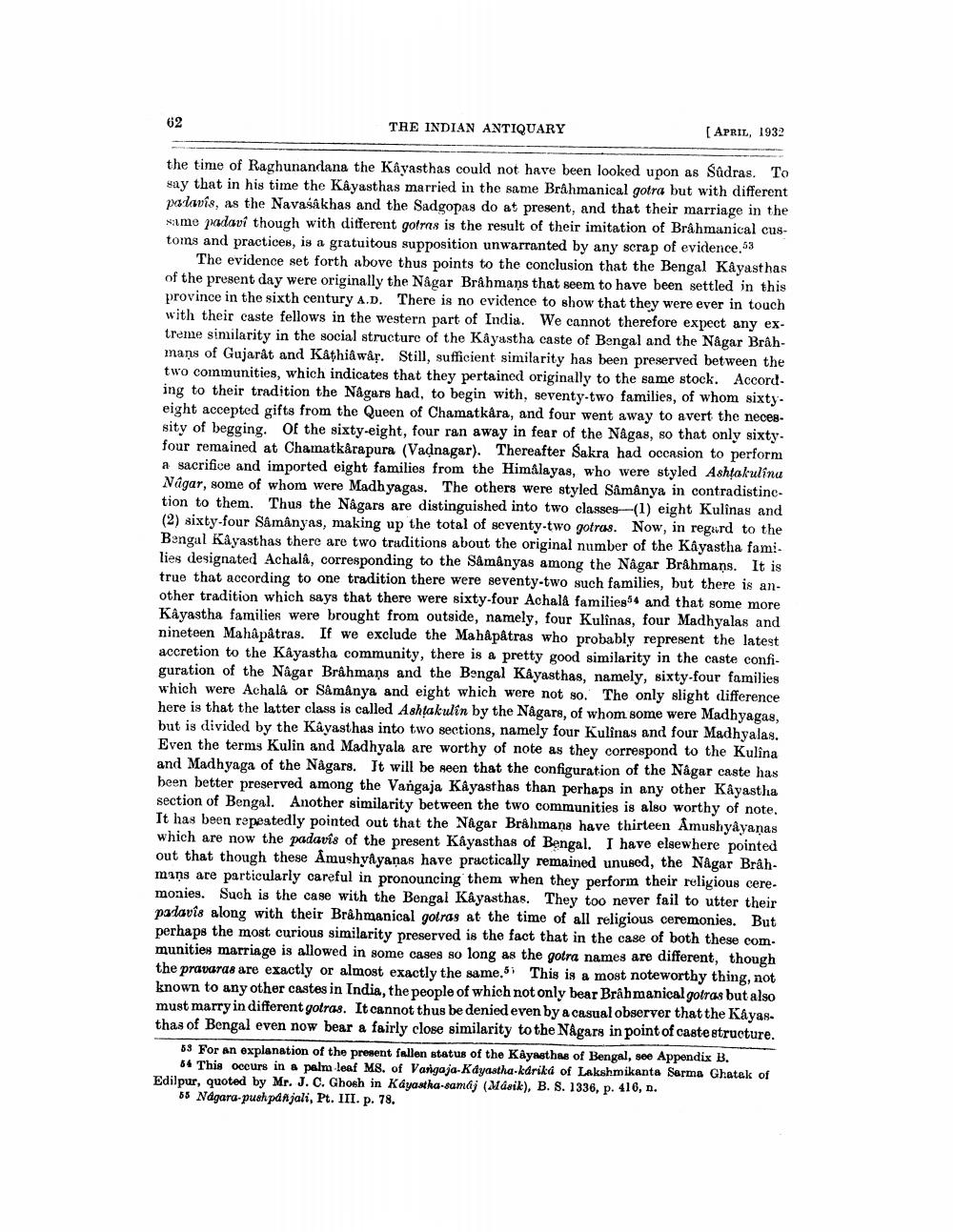________________
62
THE INDIAN ANTIQUARY
APRIL, 1932
the time of Raghunandana the Kayasthas could not have been looked upon as Sudras. To say that in his time the Kayasthas married in the same Brahmanical gotra but with different palavís, as the Navašákhas and the Sadgopas do at present, and that their marriage in the same padavi though with different gotras is the result of their imitation of Brahmanical customs and practices, is a gratuitous supposition unwarranted by any scrap of evidence.53
The evidence set forth above thus points to the conclusion that the Bengal Kayasthas of the present day were originally the Nâgar Brahmans that seem to have been settled in this province in the sixth century A.D. There is no evidence to show that they were ever in touch with their caste fellows in the western part of India. We cannot therefore expect any extreme similarity in the social structure of the Kayastha caste of Bengal and the Någar Brahmaņs of Gujarat and Kathiâwâr. Still, sufficient similarity has been preserved between the two communities, which indicates that they pertained originally to the same stock. Accord ing to their tradition the Någars had, to begin with, seventy-two families, of whom sixtyeight accepted gifts from the Queen of Chamatkára, and four went away to avert the necessity of begging. Of the sixty-eight, four ran away in fear of the Nagas, so that only sixtyfour remained at Chamatkarapura (Vadnagar). Thereafter Sakra had occasion to perform a sacrifice and imported eight families from the Himalayas, who were styled Ashtakulina Nagar, some of whom were Madhyagas. The others were styled Samânya in contradistinction to them. Thus the Någars are distinguished into two classes -(1) eight Kulînas and (2) sixty-four Sâmânyas, making up the total of seventy-two gotras. Now, in regard to the Bengal Kayasthas there are two traditions about the original number of the Kayastha fami. lies designated Achala, corresponding to the Sámányas among the Nagar Brahmans. It is true that according to one tradition there were seventy-two such families, but there is another tradition which says that there were sixty-four Achalå families and that some more Kâyastha families were brought from outside, namely, four Kulinas, four Madhyalas and nineteen Mahapatras. If we exclude the Mahâpâtras who probably represent the latest accretion to the Kayastha community, there is a pretty good similarity in the caste configuration of the Nagar Brahmans and the Bengal Kayasthas, namely, sixty-four families which were Achala or Samânya and eight which were not so. The only slight difference here is that the latter class is called Ashtakulin by the Nagars, of whom some were Madhyagas, but is divided by the Kayasthas into two sections, namely four Kulinas and four Madhyalas. Even the terms Kulin and Madhyala are worthy of note as they correspond to the Kulina and Madhyaga of the Någars. It will be seen that the configuration of the Nagar caste has been better preserved among the Vangaja Kayasthas than perhaps in any other Kayastha section of Bengal. Another similarity between the two communities is also worthy of note. It has been repeatedly pointed out that the Någar Bråhmans have thirteen Amushyâyaņas which are now the padavis of the present Kayasthas of Bengal. I have elsewhere pointed out that though these Amushyâyanas have practically remained unusod, the Nagar Brâhmans are particularly careful in pronouncing them when they perforın their religious cere. monies. Such is the case with the Bengal Kayasthas. They too never fail to utter their padavis along with their Bråhmanical gotras at the time of all religious ceremonies. But perhaps the most curious similarity preserved is the fact that in the case of both these com. munities marriage is allowed in some cases so long as the gotra names are different, though the pravaras are exactly or almost exactly the same. This is a most noteworthy thing, not known to any other castes in India, the people of which not only bear Bråhmanical gotras but also must marry in different gotras. It cannot thus be denied even by a casual observer that the Kayas. thas of Bengal even now bear a fairly close similarity to the Nagars in point of caste structure.
53 For an explanation of the present fallen status of the Kayasthas of Bengal, see Appendix B.
64 This occurs in a palm leaf Ms. of Vangaja-Kdyastha-kdrika of Lakshmikanta Serma Ghatek of Edilpur, quoted by Mr. J. C. Ghosh in Kayastka-samáj (Másik), B. S. 1336, p. 416, n.
55 Nagara-pushpanjali, Pt. III. p. 78.




